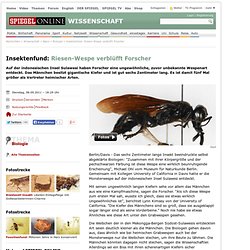

Mantis shrimp. Called "sea locusts" by ancient Assyrians, "prawn killers" in Australia and now sometimes referred to as "thumb splitters" – because of the animal's ability to inflict painful gashes if handled incautiously[4] – mantis shrimp sport powerful claws that they use to attack and kill prey by spearing, stunning, or dismemberment.

Although it only happens rarely, some larger species of mantis shrimp are capable of breaking through aquarium glass with a single strike from this weapon.[5] Ecology[edit] These aggressive and typically solitary sea creatures spend most of their time hiding in rock formations or burrowing intricate passageways in the sea bed. They either wait for prey to chance upon them or, unlike most crustaceans, at times they hunt, chase, and kill prey. Axolotl: Der Wunder-Wundenheiler - SPIEGEL ONLINE - Nachrichten - Wissenschaft. Eigentlich machen die Axolotl einen vergnügten Eindruck.
Knapp hundert der Schwanzlurche dümpeln in den Aquarien der Medizinischen Hochschule Hannover, jeweils zu zweit oder in kleinen Gruppen. Mit den Kiemenbüscheln, die ihnen wie Haare vom Kopf abstehen, und ihrem scheinbar lächelnden Maul wirken die Axolotl sympathisch. Und sie sind neugierig. Nähert man sich ihren Bassins, kommen sie an die Scheibe geschwommen und drücken ihre winzigen Vorderfüße dagegen. Einige aber sehen anders aus, ihnen fehlt ein Arm oder ein Bein. Forscher haben den Lurchen Teile der Gliedmaßen amputiert oder Hautlappen entfernt, um ihre Regenerationsfähigkeit zu untersuchen.
Amazing jellyfish lake. Jellyfish Lake is a marine lake located on Eil Malk island in Palau.

Eil Malk is part of the Rock Islands, a group of small, rocky, mostly uninhabited islands in Palau’s Southern Lagoon, between Koror and Peleliu. It is notable for the millions of golden jellyfish which migrate horizontally across the lake daily. photo source Jellyfish Lake is connected to the ocean through fissures and tunnels in the limestone of ancient Miocene reef. However the lake is sufficiently isolated and the conditions are different enough that the diversity of species in the lake is greatly reduced from the nearby lagoon. Mating chirps, fighting sperm, hero ants - it's sex and society in the insect world. CBBC Newsround: News and fun facts for kids - Very rare white humpback whale spotted in Australia.
Insektenfund: Riesen-Wespe verblüfft Forscher - SPIEGEL ONLINE - Nachrichten - Wissenschaft. Berlin/Davis - Das sechs Zentimeter lange Insekt beeindruckte selbst abgeklärte Biologen: "Zusammen mit ihrer Körpergröße und der pechschwarzen Färbung ist diese Wespe eine wirklich beunruhigende Erscheinung", Michael Ohl vom Museum für Naturkunde Berlin.

Gemeinsam mit Kollegen University of California in Davis hatte er die Monsterwespe auf der indonesischen Insel Sulawesi entdeckt. Mit seinen ungewöhnlich langen Kiefern sehe vor allem das Männchen aus wie eine Kampfmaschine, sagen die Forscher. Monster Crab Exits Shell Video. Mimic Octopus. Squidly. Story and photos by Scott Cassell Under an orange moon, Jacquie and I are 75 feet deep in the Sea of Cortez waiting for demons to appear.

As we search the black water below our camera lights, a green glow begins to move toward us. Bioluminescence is signaling the approach of a shoal of Giant Humboldt squid rising to investigate us. There’s no doubt they’re hungry… The Master of the Desert Sea For five years I had been studying to make this dive in the Sea of Cortez, also known as the Gulf of California, which divides Mexico’s Baja California peninsula from the mainland. For most people, the word “squid” probably conjures images of deep-fried appetizers, not flesh-eating carnivores. In addition to the Humboldt’s enormity and impressive array of weapons, this magnificent mollusk possesses a legendary ferocity.
These stories were true and I knew it. Armor Is The Only Way To Survive This Dive One particular moment I will never forget occurred during the first dive of the scouting expedition. The Ark In Space: The Incredible Glasswing Butterfly. A butterfly with transparent wings?

Surely not. Yet there is a species that exhibits this trait. Take a close look at the incredible Glasswing, an enchanting species that confounds science. Greta oto may sound like the name of a silent movie star from Eastern Europe but is in fact the scientific name for one of the most exquisite – and little known – species of butterfly on the planer. Insekten-Evolution: Schraubgewinde lassen Käfer besser klettern - SPIEGEL ONLINE - Nachrichten - Wissenschaft. Ans Innere einer Nuss zu gelangen, gelingt dem goldbraunen Haselnussbohrer problemlos: Mit seinem langen, dünnen Rüssel durchsticht der Käfer einfach die harte Schale einer reifenden Nuss.

Die Weibchen legen später ein Ei hinein, so dass die Larve sich von der Frucht ernähren kann, während sie wächst. Um an die Nüsse zu gelangen, müssen die Rüsselkäfer Pflanzen erklimmen und sich gut an den Blättern festhalten können. Dafür brauchen sie fitte Beine und bewegliche Gelenke. NMNH IZ Features - leeches. 3.24.2005 - Octopuses occasionally stroll around on two arms, UC Berkeley biologists report. UC Berkeley Press Release Octopuses occasionally stroll around on two arms, UC Berkeley biologists report By Robert Sanders, Media Relations | 24 March 2005 BERKELEY – Two species of tropical octopus have evolved a neat trick to avoid predators - they lift up six of their arms and walk backward on the other two.

This first report of bipedal behavior in octopuses, written by University of California, Berkeley, researchers, will be published in the March 25 issue of Science. When walking, these octopuses use the outer halves of their two back arms like tank treads, alternately laying down a sucker edge and rolling it along the ground. UC Berkeley graduate student Crissy Huffard clocked the two-legged speed of one coconut octopus at two and a half inches per second, while a second individual zoomed along, backwards, at five and a half inches per second. Not so when walking. "This bipedal behavior allows them to get away and remain cryptic," said Huffard.